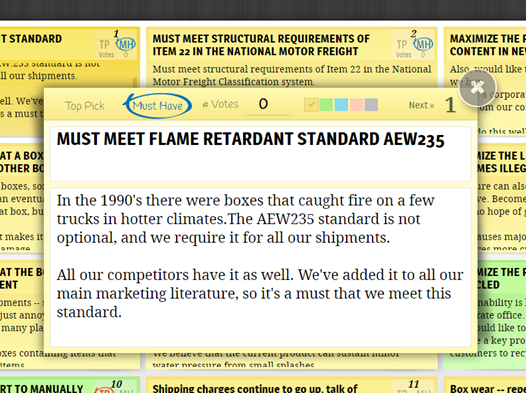- BLUE HELP
- Discovery Interviews (Step 2)
- How to identify Must Haves (MH)
-
Blueprinting Center & Methodology
- What is New Product Blueprinting?
- How is Blueprinting learned and applied?
- Blueprinting Center
- Blueprinting E-Learning Course
- How can I become Certified in New Product Blueprinting?
- How does Blueprinting fit with a stage-and-gate process?
- How does Blueprinting fit with strategic planning?
- How does Blueprinting fit with Design Thinking?
- How does Blueprinting fit with Lean Startup?
- How does Blueprinting fit with Minesweeper de-risking?
- How does Blueprinting fit with LaunchStar product launch?
- What innovation metrics should we use?
- What is "Jobs-to-be-Done?"
-
Blueprinter® Software
-
Market Segmentation (Step 1)
-
Discovery Interviews (Step 2)
- How to plan Discovery interviews
- Preparing your interview team
- Convincing customers to be interviewed
- How to handle confidential info in an interview
- How to conduct a Discovery interview
- Finding & using a digital projector for interviews
- How to conduct a customer tour
- How to debrief & follow-up a Discovery interview
- Engaging your sales colleagues in interviews
- Engaging distributors in interviews
- Interviewing customers down the value chain
- How to interview remotely with web-conferences
- How to interview at trade shows & other venues
- Interviewing in different global cultures & languages
- How to listen well during customer interviews
- How to probe during customer interviews
- How to gather economic data during interviews
- How to create & use Current State questions
- How to identify Must Haves (MH)
- How to select Top Picks (TP)
- How to use Trigger Maps
- How to form Outcome Statements
-
Preference Interviews (Step 3)
-
Rest of Blueprinting (Steps 4-7)
-
Everyday VOC
-
Minesweeper® De-risking
1. What is a Must Have?
A Must Have is "table-stakes"... absolutely required or customers can't use your product.
Your main goal in Discovery interviews is to uncover and understand customers’ outcomes… their desired end-results. You’ll record one outcome per sticky note, and by the end of the interview you’ll typically mark 5-to-10 them as Top Picks (TPs)… those outcomes customers are most eager to see improved.
During the interview, you’ll likely also hear some Must Haves (MHs). These are outcomes the customers must have or they could not use your product. You’ll mark these MHs as you go, and it’s a good idea to ask if there are any others at the end of the interview. Later, in Preference interviews, you’ll show customers the list of Must Haves you’ve collected at all Discovery interviews and ask if they agree with each.

Examples of Must Haves include:
- Must meet this certification standard
- Must not contain any heavy metals
- Must last 1000 service hours
Sometimes the Must Have is binary: The outcome is either satisfied or not—there’s no middle ground. The first two examples above fall into this category. In other cases, the Must Have is continuous, e.g., must last 1000 service hours.
Sometimes interview teams--and their customers--get confused about the difference between a Must Have (MH) and a Top Pick (TP). It's important to be clear about these definitions. The next BlueHelp article, Don't confuse Must Haves and Top Picks, should help. For more on Must Haves, see e-Learning Module: Discovery Interviews at www.blueprintingcenter.com > e-Learning.
Keywords: must have, must-have, required, table-stakes, price-of-entry, binary must have, continuous must have, MH
